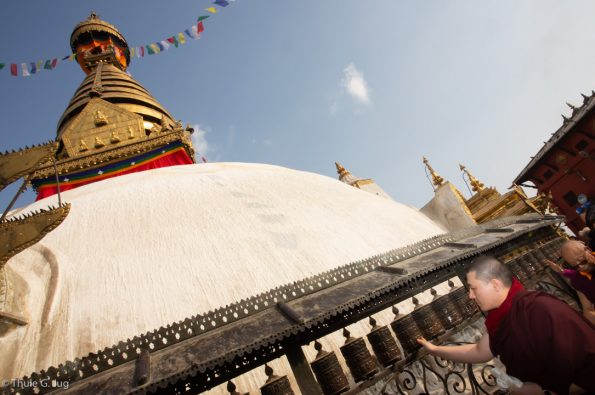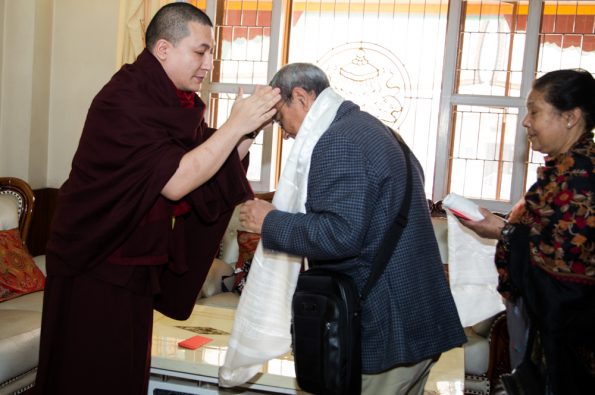The bodhisattva vow is the essential theme of Mahayana Buddhism. On this particular spiritual path, the practitioner focusses on generating wisdom and compassion – i.e. bodhicitta.
With genuine loving kindness and compassion the practitioner wants to help limitless sentient beings so that they achieve well-being and the ultimate joy of enlightenment. And, in order to gain the ability to help sentient beings in achieving this, the practitioner strives to develop the wisdom of buddha, the enlightened state. Based on loving kindness as the ever present attitude, a bodhisattva therefore focusses on accomplishing the fruit, i.e. buddha, the enlightened state, and on practicing the causes that will ripen to this result, namely the six transcendent qualities of giving, patience, ethics, joyous effort, meditation, and wisdom. With the bodhisattva vow the practitioner commits himself to a bodhisattva’s way of life. The bodhisattva vow is taken during a specific ceremony in the presence of an authentic spiritual master. It is said to be the essential step in the spiritual development of a person who wishes to follow in the Buddha’s footsteps. Shantideva, one of the great Indian masters of Buddhism, explained the benefits of generating bodhicitta as follows: “In someone who has fully adopted this attitude, who is determined to never turn away from completely liberating the infinite forms of life, the power of merit equal to space will perpetually ensue even during his sleep or at moments of inattentiveness.”
Bodhicitta – the central practice of a bodhisattva – comprises various aspects. There is on the one hand the so-called ultimate bodhicitta which denotes the true nature of mind, i.e. its emptiness and luminosity, as well as the efforts to actualize it.
On the other hand there is the so-called relative bodhicitta which pertains to those states of mind and types of training a regular person without insight into emptiness is capable to generate and to engage in. “Relative” therefore has to do with the way we perceive the world and ourselves.
The focal point of relative bodhicitta is the welfare of sentient beings. As this is a bodhisattva’s main concern, someone who strives to become a bodhisattva must train in genuinely developing this concern. The practitioner therefore trains his mind to broaden his attitude so that the needs of others are what counts most.
This way, the Mahayana methods of mind training are designed to enable a practitioner to generate loving kindness and compassion. And it is on this basis that relative bodhicitta can genuinely arise in the practitioner’s mind.
Bodhisattva Vow
Then, in a certain ceremony, an authentic spiritual Mahayana master guides the student through a process where he is finally able to take the bodhisattva vow.
• The practitioner commits himself to the bodhicitta of aspiration: having generated loving kindness and compassion he is fully aware of the necessity to benefit sentient beings. Focusing on the wish to bring about the welfare of sentient beings he knows that as a prerequisite, he has to become capable of actually helping others. Therefore he strives towards the attainment of buddha, the enlightened state, so that he achieves the required abilities. Thus, the bodhicitta of aspiration is to commit to and focus on the goal of accomplishing buddha, the enlightened state.
• In addition, the practitioner commits himself to the bodhicitta of application: he vows to train in all those transcending qualities by means of which the goal is reached, i.e. the six paramitas of giving, patience, ethics, joyous effort, meditation, and wisdom.
Both, with respect to the bodhicitta of aspiration and application, the true commitment is of the utmost importance. The practitioner actually takes a vow. Therefore, it is not enough to simply repeat the words or to think them through. It is a matter of actual commitment towards this goal and the path that brings about its accomplishment.
The teachings for developing bodhicitta were passed on in two major transmission lineages: the “Tradition of the Profound View“ which Buddha Shakyamuni taught his disciple Manjushri and which was later passed on by the master Nagarjuna, as well as the “Tradition of the Vast Conduct” which Buddha taught his disciple Maitreya and which was passed on by Asanga. In terms of their meaning, these two traditions are identical but there are differences in the proceedings of the ceremony.
The overall structure the ceremonies carried out to transmit the “Tradition of the Profound View” comprises the following three steps:
• the preparation,
• the actual taking of the vow,
• and the conclusion.
The Preparation
In preparation and in order to generate vast merit, the student goes through seven particular types of practice. First he venerates the Buddhas and bodhisattvas, prostrating to them. This is followed by the practice of making offerings. The main point about offerings is that the student offers something beautiful or valuable without the slightest attachment. These offerings may be flowers, incense, etc. The next step is to regret previous negative deeds. Then he rejoices in his good deeds and those of others; this is followed by requesting the Buddhas and bodhisattvas to remain active in this world; next the student asks them to teach the Buddha-Dharma and finally he dedicates the power of good to the welfare of all beings.
The student then goes on to take refuge in the Three Jewels until he achieves buddha, the enlightened state. With a focussed mind and filled with devotion he repeats the following verses for taking the Buddhist Mahayana refuge three times:
Until I reach the heart of enlightenment, I take refuge in the buddhas.
In the same way I take refuge in the dharma and in the assembly of bodhisattvas.
Following this, it would be excellent to focus on the Mahayana mind training so that the student can truly make the bodhisattva commitment. On the one hand the focus is on the understanding of the essencelessness of the individual self and of all things in general. On the other hand the practitioner thinks of all sentient beings, limitless in number, developing a genuine sense of concern for them, i.e. all-encompassing loving kindness and compassion.
The Actual Vow
At this point the practitioner should generate a sense of great joy and deep inspiration with respect to bodhicitta, trying to understand that this is the one and only path towards buddha, the enlightened state. In addition, it is important to feel certain that the master in whose presence the vow is taken is a high bodhisattva and therefore capable of truly helping the practitioner to generate this commitment to develop bodhicitta. The practitioner should therefore be full of devotion and certainty that he truly receives the vow as he repeats the following phrases three times:
Just as in the past the buddhas have developed bodhicitta and have progressively stabilised in their bodhisattva training,
likewise, for the benefit of beings,
I will also develop bodhicitta and train myself progressively in its application.
The Conclusion
First the practitioner rejoices in this milestone of his spiritual development: by taking the bodhisattva vow he has become a bodhisattva, someone following in the Buddha’s footsteps. In other words he or she now belongs to the Buddha’s family, is a daughter or a son of the Buddha proceeding towards buddha, the enlightened state. We should be aware that through this, the practitioner’s samsaric existences will come to an end. For this reason the practitioner also resolves to do everything to live up to the bodhisattva commitment, and to do so joyfully. This is what the practitioner keeps in mind when repeating the following verses:
Now my life has become fruitful.
I am fortunate to have attained a precious human existence.
Today I am born into the family of buddhas. I am a bodhisattva.
From now on, whatever happens, I will only perform actions
that are in accordance with the supreme qualities.
I will act such that I will never stain the perfect and supreme qualities of the buddhas.
Secondly, the practitioner encourages others to be joyful as well because he promised everyone to help them achieve temporary and ultimate well-being. This is a good reason for others to be delighted. By reciting the following words the practitioner therefore invites others to rejoice as well:
Today, in the presence of all the protectors,
I invite all beings to enjoy happiness
until the state of buddhahood is reached.
Devas, asuras and all others, rejoice!
After the vow it is good to make an offering to the spiritual master who gave the vow. The offering should be adequate and perfect as this is the symbolic substance accompanying the step of having generated bodhicitta. Along with this, the practitioner practices paths of aspiration, wishing that the virtue generated through the power of bodhicitta and the offerings may contribute to the well-being and the spiritual development of all sentient beings; and that everything conducive for this development come together.
Dedication
The end of the ceremony is followed by the dedication of the merit accrued:
May the precious bodhicitta be developed by those who have not yet developed it.
May it not diminish in those who have already developed it.
May it expand further and further.
May I never lose bodhicitta and may I always engender bodhicitta behaviour.
May the buddhas care for me, and may I abandon all harmful actions.
May the wishes of the bodhisattvas for the benefit of all beings be fulfilled.
May sentient beings attain whatever the buddhas wish for them.
May all beings be endowed with happiness.
May the lower realms be forever empty.
May the wishing prayers of the bodhisattvas abiding in the different levels be accomplished.


